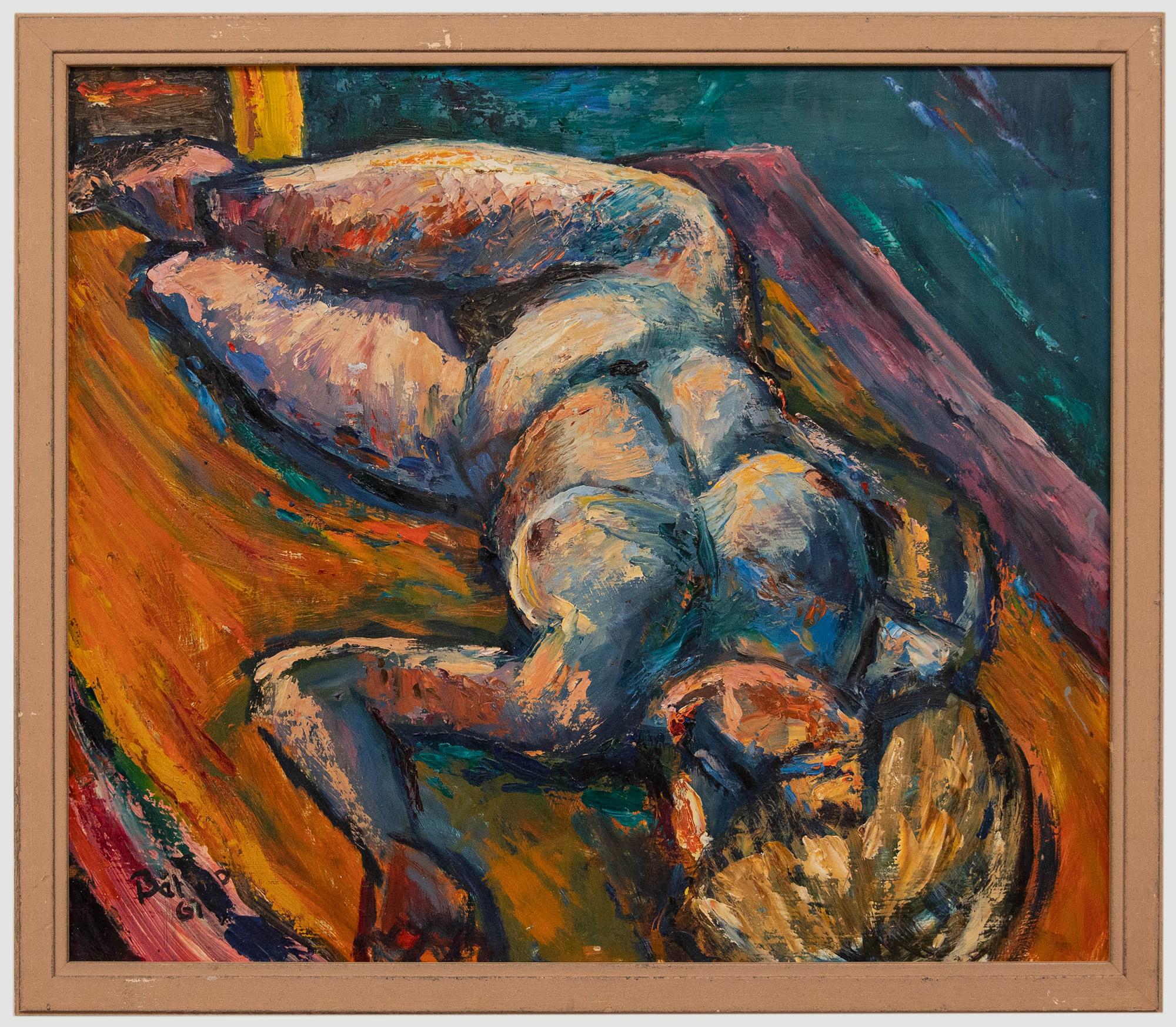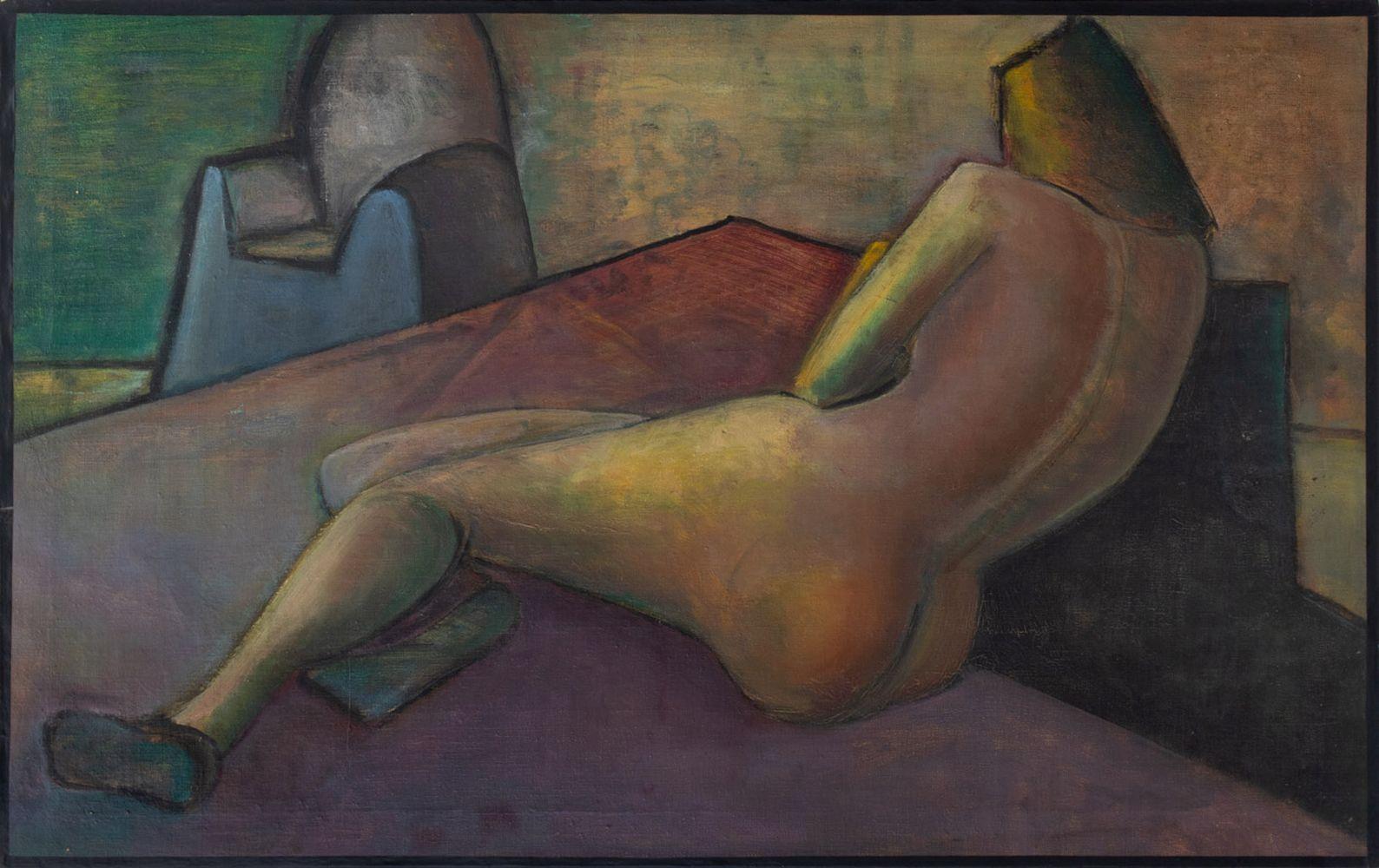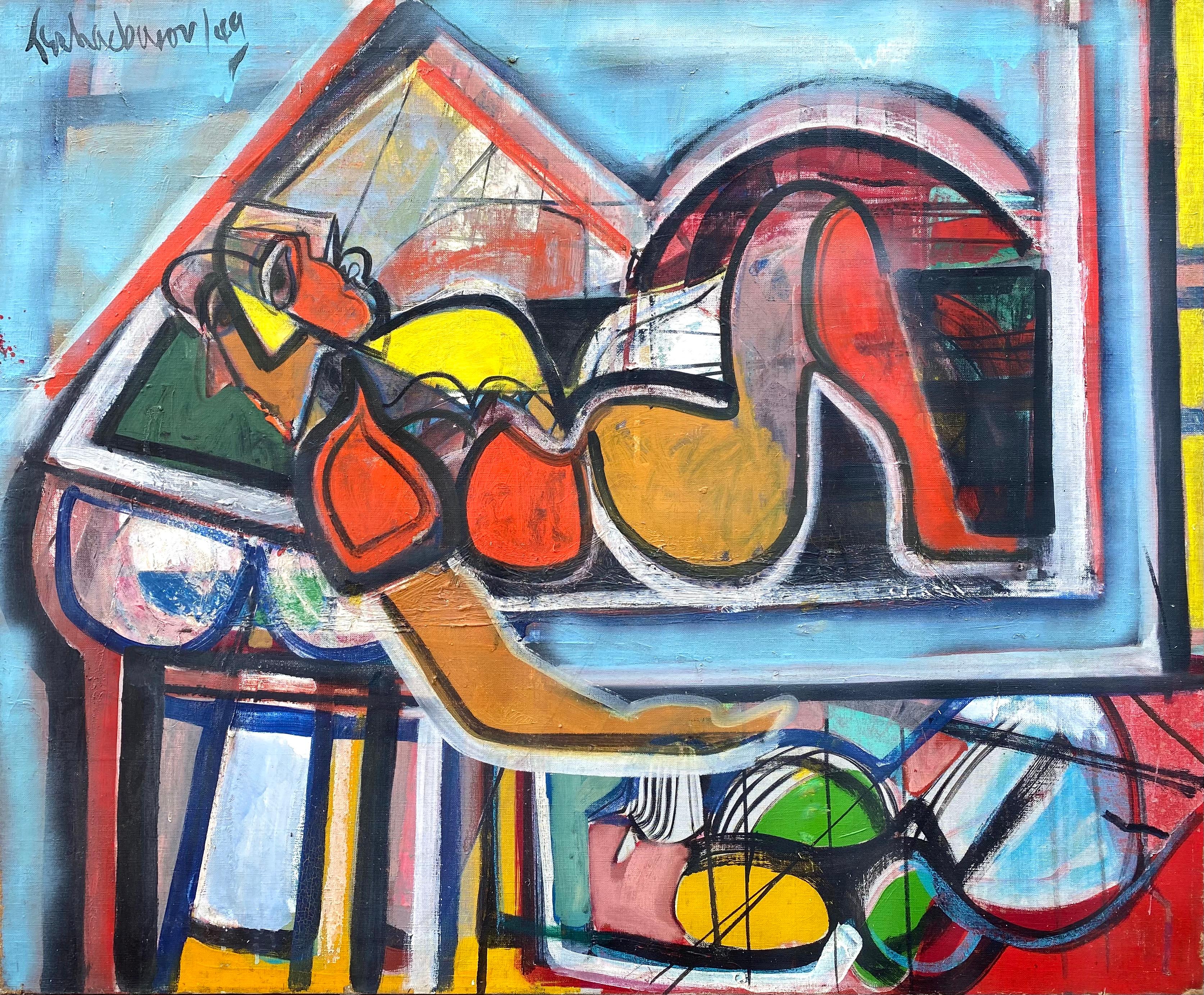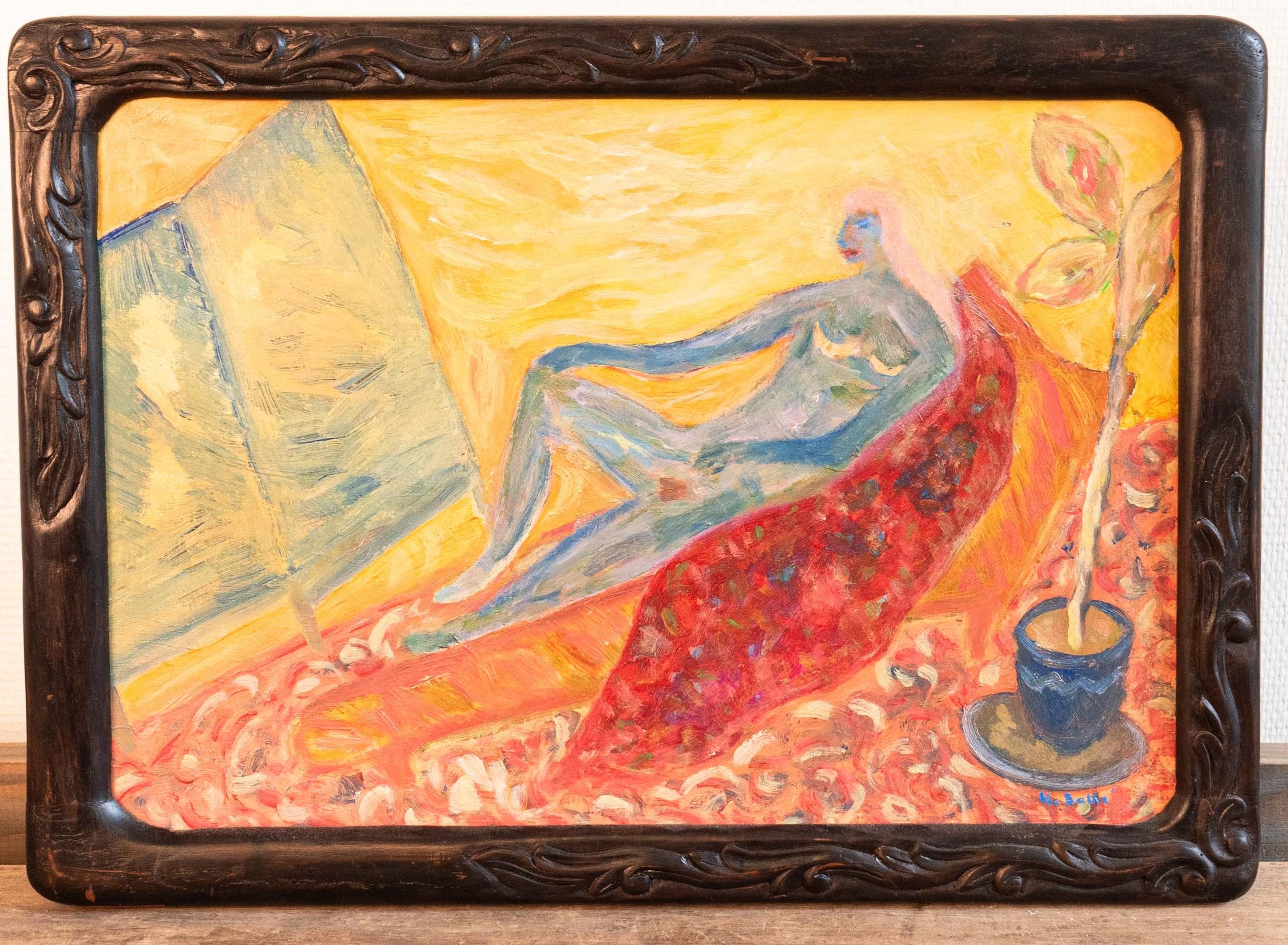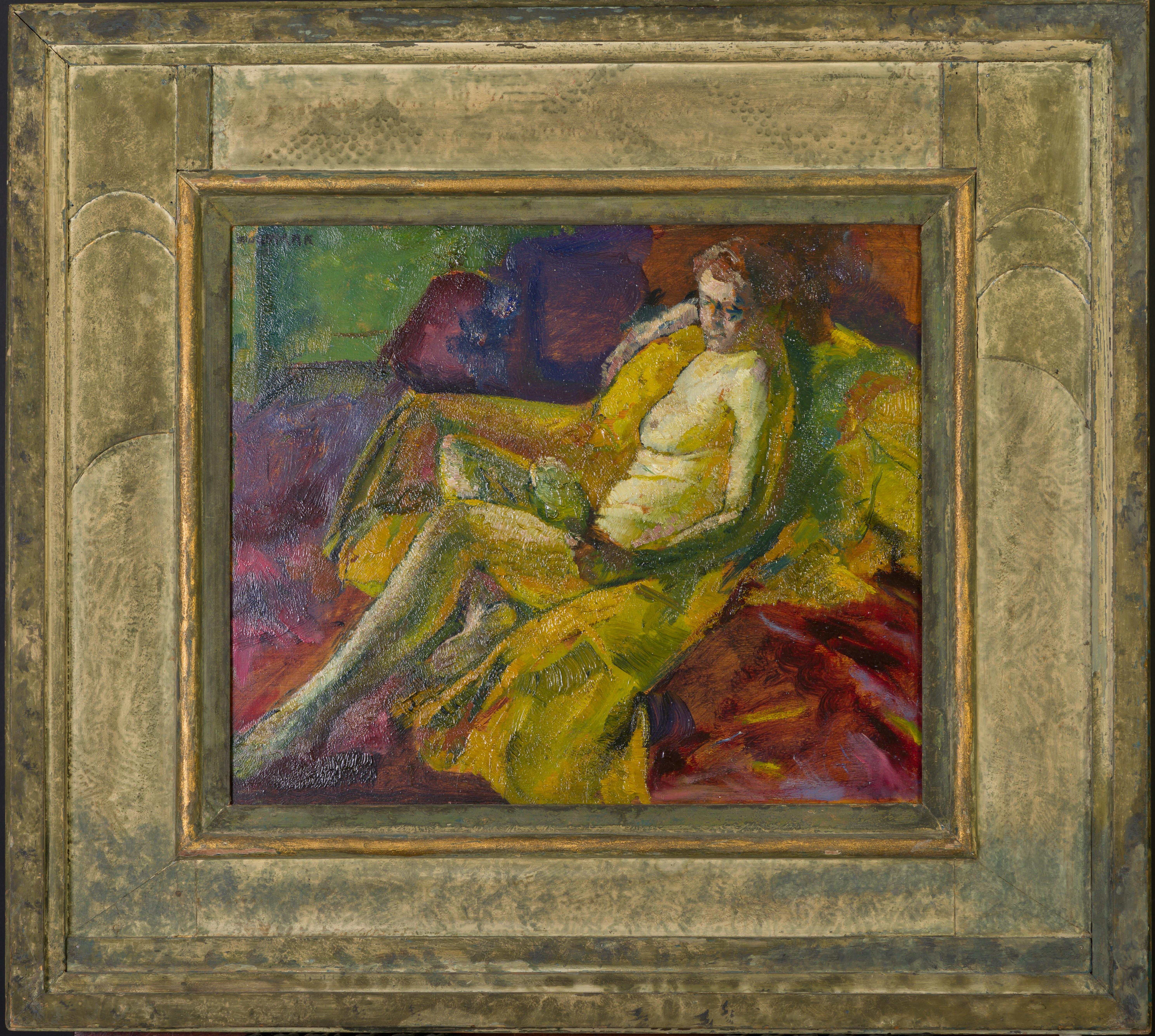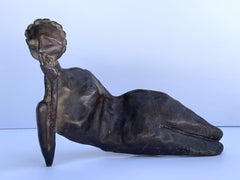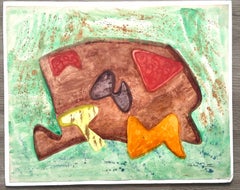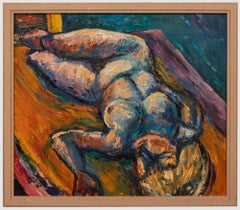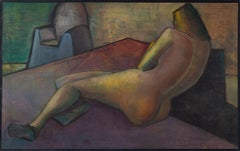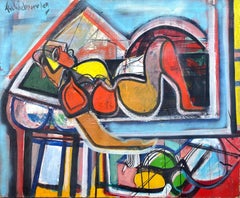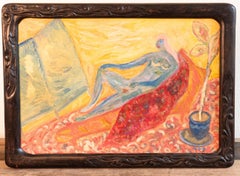Want more images or videos?
Request additional images or videos from the seller
1 of 10
Edwin KosarekReclining Nude1951
1951
$800
$1,50046% Off
£611.07
£1,145.7646% Off
€702.19
€1,316.6146% Off
CA$1,142.01
CA$2,141.2646% Off
A$1,252.12
A$2,347.7246% Off
CHF 653.85
CHF 1,225.9646% Off
MX$15,067.68
MX$28,251.9146% Off
NOK 8,240.70
NOK 15,451.3146% Off
SEK 7,748.38
SEK 14,528.2046% Off
DKK 5,244.09
DKK 9,832.6746% Off
About the Item
Edwin Kosarek (b.1929). Reclining Nude, 1952. Oil on wood panel, 17 x 48 inches. Signed and dated on verso.
Edwin Kosarek
Born: 1929
Studied: The City College, NYC. Cooper-Union, NYC. Pupil of Charles Gwathmey.
- Creator:Edwin Kosarek (1929, American)
- Creation Year:1951
- Dimensions:Height: 29 in (73.66 cm)Width: 25 in (63.5 cm)Depth: 2 in (5.08 cm)
- Medium:
- Movement & Style:
- Period:
- Condition:
- Gallery Location:Wilton Manors, FL
- Reference Number:1stDibs: LU245211405042
About the Seller
4.9
Platinum Seller
Premium sellers with a 4.7+ rating and 24-hour response times
Established in 2007
1stDibs seller since 2015
425 sales on 1stDibs
Typical response time: 3 hours
- ShippingRetrieving quote...Shipping from: Wilton Manors, FL
- Return Policy
Authenticity Guarantee
In the unlikely event there’s an issue with an item’s authenticity, contact us within 1 year for a full refund. DetailsMoney-Back Guarantee
If your item is not as described, is damaged in transit, or does not arrive, contact us within 7 days for a full refund. Details24-Hour Cancellation
You have a 24-hour grace period in which to reconsider your purchase, with no questions asked.Vetted Professional Sellers
Our world-class sellers must adhere to strict standards for service and quality, maintaining the integrity of our listings.Price-Match Guarantee
If you find that a seller listed the same item for a lower price elsewhere, we’ll match it.Trusted Global Delivery
Our best-in-class carrier network provides specialized shipping options worldwide, including custom delivery.More From This Seller
View AllUntitled (Abstract Expressionist Painting)
Located in Wilton Manors, FL
Max Schnitzler (1903-1999).
Untitled, ca. 1950's
Oil on canvas measuring 18 x 24 inches.
Unframed.
Minor area of paint loss at margin upper left.
Category
Mid-20th Century Abstract Abstract Paintings
Materials
Oil
Reclining Figure (woman)
By William King (b.1925)
Located in Wilton Manors, FL
William King (1925-2015). Reclining figure, ca. 1965. Cast and welded bronze, 7 x 9.5 x 5 inches. Unsigned.
William King, a sculptor in a variety of materials whose human figures traced social attitudes through the last half of the 20th century, often poking sly and poignant fun at human follies and foibles, died on March 4 at his home in East Hampton, N.Y. He was 90.
His death was confirmed by Scott Chaskey, who is married to Mr. King's stepdaughter, Megan Chaskey.
Mr. King worked in clay, wood, bronze, vinyl, burlap and aluminum. He worked both big and small, from busts and toylike figures to large public art pieces depicting familiar human poses -- a seated, cross-legged man reading; a Western couple (he in a cowboy hat, she in a long dress) holding hands; a tall man reaching down to tug along a recalcitrant little boy; a crowd of robotic-looking men walking in lock step.
But for all its variation, what unified his work was a wry observer's arched eyebrow, the pointed humor and witty rue of a fatalist. His figurative sculptures, often with long, spidery legs and an outlandishly skewed ratio of torso to appendages, use gestures and posture to suggest attitude and illustrate his own amusement with the unwieldiness of human physical equipment.
His subjects included tennis players and gymnasts, dancers and musicians, and he managed to show appreciation of their physical gifts and comic delight at their contortions and costumery. His suit-wearing businessmen often appeared haughty or pompous; his other men could seem timid or perplexed or awkward. Oddly, or perhaps tellingly, he tended to depict women more reverentially, though in his portrayals of couples the fragility and tender comedy inherent in couplehood settled equally on both partners.
Mr. King's work is in the collections of the Metropolitan Museum of Art and the Museum of Modern Art in New York and the Smithsonian American Art Museum in Washington, among other places, and he had dozens of solo gallery shows in New York and elsewhere. But the comic element of his work probably caused his reputation to suffer.
Reviews of his exhibitions frequently began with the caveat that even though the work was funny, it was also serious, displaying superior technical skills, imaginative vision and the bolstering weight of a range of influences, from the ancient Etruscans to American folk art to 20th-century artists including Giacometti, Calder. and Elie Nadelman.
The critic Hilton Kramer, one of Mr. King's most ardent advocates, wrote in a 1970 essay accompanying a New York gallery exhibit that he was, "among other things, an amusing artist, and nowadays this can, at times, be almost as much a liability as an asset."
A "preoccupation with gesture is the focus of King's sculptural imagination," Mr. Kramer wrote. "Everything that one admires in his work - the virtuoso carving, the deft handling of a wide variety of materials, the shrewd observation and resourceful invention - all this is secondary to the concentration on gesture. The physical stance of the human animal as it negotiates the social arena, the unconscious gait that the body assumes in making its way in the social medium, the emotion traced by the course of a limb, a torso, a head, the features of a face, a coiffure or a costume - from a keen observation of these materials King has garnered a large stock of sculptural images notable for their wit, empathy, simplicity and psychological precision."
William Dickey King...
Category
Mid-20th Century Abstract Abstract Sculptures
Materials
Bronze
$2,800 Sale Price
30% Off
Abstract Composition
Located in Wilton Manors, FL
Chris Ritter (1906-1976). Abstract Composition ca. 1960.
Watercolor on rag paper, sheet measures 17.5 x 22 inches.
Sheet is loose and unmounted. Unframed.
Estate stamps500 on v...
Category
Mid-20th Century Cubist Abstract Paintings
Materials
Watercolor, Rag Paper
Abstract Composition
Located in Wilton Manors, FL
Chris Ritter (1906-1976). Abstract Composition ca. 1960.
Watercolor on rag paper, sheet measures 17.5 x 22 inches.
Sheet is loose and unmounted. Unframed.
Estate stamps500 on v...
Category
Mid-20th Century Cubist Abstract Paintings
Materials
Watercolor, Rag Paper
Untitled
By Roland Ayers
Located in Wilton Manors, FL
Roland Ayers (1932-2017). Untitled, 1983. Ink on paper, measures 17 x 23 inches. Unframed and unmounted. Signed and dated lower left. Ayers holds the distinction of having participated in the first important survey of African-Americans, Contemporary Black Artists in America, a 1971 show at The Whitney.
Biography:
Artist and art educator, Roland Ayers was born on July 2, 1932, the only child of Alice and Lorenzo Ayers, and grew up in the Germantown district of Philadelphia. Ayers served in the US Army (stationed in Germany) before studying at the Philadelphia College of Art (currently University of the Arts). He graduated with a BFA in Art Education, 1954. He traveled Europe 1966-67, spending time in Amsterdam and Greece in particular. During this period, he drifted away from painting to focus on linear figurative drawings of a surreal nature. His return home inaugurated the artist’s most prolific and inspired period (1968-1975). Shorty before his second major trip abroad in 1971-72 to West Africa, Ayers began to focus on African themes, and African American figures populated his work almost exclusively.
In spite of Ayers’ travel and exploration of the world, he gravitated back to his beloved Germantown, a place he endowed with mythological qualities in his work and literature. His auto-biographical writing focuses on the importance of place during his childhood. Ayers’ journals meticulously document the ethnic and cultural make-up of Germantown, and tell a compelling story of class marginalization that brought together poor families despite racial differences. The distinctive look and design of Germantown inform Ayers’ visual vocabulary. It is a setting with distinctive Gothic Revival architecture and haunting natural beauty. These characteristics are translated and recur in the artist’s imagery.
During his childhood, one of the only books in the Ayers household was an illustrated Bible. The images within had a profound effect on the themes and subjects that would appear in his adult work. Figures in an Ayers’ drawing often seem trapped in a narrative of loss and redemption. Powerful women loom large in the drawings: they suggest the female role models his journals record in early life. The drawings can sometimes convey a strong sense of conflict, and at other times, harmony. Nature and architecture seem to have an antagonistic relationship that is, ironically, symbiotic.
A critical turning point in the artist’s career came in 1971 when he was included in the extremely controversial Whitney Museum show, Contemporary Black Artists in America. The exhibition gave Ayers an international audience and served as a calling card for introductions he would soon make in Europe.
Ayers is a particularly compelling figure in a period when black artists struggled with the idea of authenticity. A questioned often asked was “Is your work too black, or not black enough?” Abstractionists were considered by some peers to be sell-outs, frauds or worse. Figurative* work was accused of being either sentimental or politically radical depending on the critical source. Ayers made the choice early on to be a figurative artist, but considered his work devoid of political content.
Organizations such as Chicago’ s Afri-Cobra in the late 1960‘s asserted that the only true black art of any relevance must depict the black man and woman...
Category
1980s Abstract Abstract Paintings
Materials
Paper, Ink
$960 Sale Price
20% Off
Portrait of Young Man Reclining
By Patrick Terenchin
Located in Wilton Manors, FL
Patrick Terenchin ( b. 1970).
Portrait of Young Man Reclining, 2024.
Oil on board, measuring 22 x 30 inches; 23 x 31 inches framed.
Signed a...
Category
2010s Abstract Impressionist Figurative Paintings
Materials
Oil, Board
$800 Sale Price
68% Off
You May Also Like
Mid 20th Century Oil - Reclining Nude
Located in Corsham, GB
A vibrant and expressive study of a reclining nude. Well-presented in a painted wooden frame. Indistinctly signed and dated to the lower left. On board.
Category
20th Century Nude Paintings
Materials
Oil
$300 Sale Price
20% Off
Reclining Female Nude
Located in Astoria, NY
Leonard Feldman (American, XX), Reclining Female Nude, Oil on Canvas, initialed "L.F." to verso, unframed. 24.25" H x 38.25" W. Provenance: From the Allen Tucker Memorial Collection.
Category
Mid-20th Century Cubist Nude Paintings
Materials
Canvas, Oil
“Reclining Figures”
By Nahum Tschacbasov
Located in Southampton, NY
Beautiful oil on canvas painting with aerosol spray paint of two reclining figures by the well known Russian/American artist, Nahum Tschacbasov. Signed upper right and dated 1949. ...
Category
1940s Abstract Expressionist Figurative Paintings
Materials
Canvas, Oil
Reclining Nude
Located in Oostende, BE
This nude by Belgian artist Martin Bollé is made in oil on cardboard, elegantly framed in an Art Nouveau style frame.
Category
Mid-20th Century Impressionist Nude Paintings
Materials
Oil, Cardboard
Reclining Nude
By Alfred Aaron Wolmark
Located in Douglas, Isle of Man
Alfred Aaron Wolmark R.A. 1877-1961, was a portrait and decorative genre subject painter. Born in Warsaw and travelled to England in 1894 where he remained. He was a painter of impre...
Category
Early 20th Century Nude Paintings
Materials
Oil, Wood Panel
Reclining Figure
By Henryk Berlewi
Located in London, GB
HENRYK BERLEWI 1894-1964
Warsaw 1894-1964 Paris (Polish/French)
Title: Reclining Figure
Technique: Original Signed Oil Painting on canvas laid on ...
Category
1960s Impressionist Figurative Paintings
Materials
Oil
More Ways To Browse
Used Recliners
Oil Painting Reclining Nude
Charles Gwathmey
Edwin Kosarek
48 X 48 Painting
Yale Mfa
Lawrence Gallery
Pink And Blue Painting
Non Objective Art
Paintings On Aluminum
Clyfford Still
Richard Painter
George Washington Paintings and Portraits
Mark Rothko Works On Paper
Abstract Boats
Fantasy Oil Painting
Minimalist Abstract Oil Painting
Fluid Art
